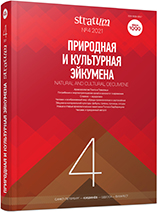Преднамеренно деформированные черепа из могильника Фронтовое-3
Artificially Deformed Skulls from the Frontovoe 3 Burial Ground
Author(s): Natalia G. Svirkina, Maria V. DobrovolskayaSubject(s): History, Anthropology, Archaeology, Customs / Folklore, Gender history, Ancient World
Published by: Издательский дом Stratum, Университет «Высшая антропологическая школа»
Keywords: Northern Black Sea region; Roman Period; infant care traditions; cultural markers;
Summary/Abstract: The paleoanthropological materials from fully studied 228 burials of Frontovoye-3 burial ground it is possible to characterize the deformed skulls frequency and their shape in burials dating back to late 1st — early 5th centuries AD. We esteem the tradition of baby’s head artificial deformation as related to gender culture, which is passed on from one generation of women to the next. There were found only seven cases of deformities, which is less than 3% of the total number of individuals studied. With the contours of the skull sagittal sutures compared, traces of slight annular deformation were found on six male skulls of mature and older age. The skull of one young woman shows traces of annular deformation with the effect of slight skull elongation. We discuss the hypothesis that the tradition of insignificant deformation of baby’s head was observed by a very limited part of society. Nevertheless, this tradition has been preserved throughout the entire existence of the necropolis. The same picture can be observed in a series of paleoanthropological materials from the Roman period from the necropolises of Chersonesos, Phanagoria, and burial grounds of the Abrau Peninsula. This situation contrasts with the high frequency and significant severity of deformed skulls among the population of the Lower Don and Volga regions, Northern Ciscaucasia.
Journal: Stratum plus. Археология и культурная антропология
- Issue Year: 2021
- Issue No: 4
- Page Range: 149-157
- Page Count: 9
- Language: Russian
- Content File-PDF

